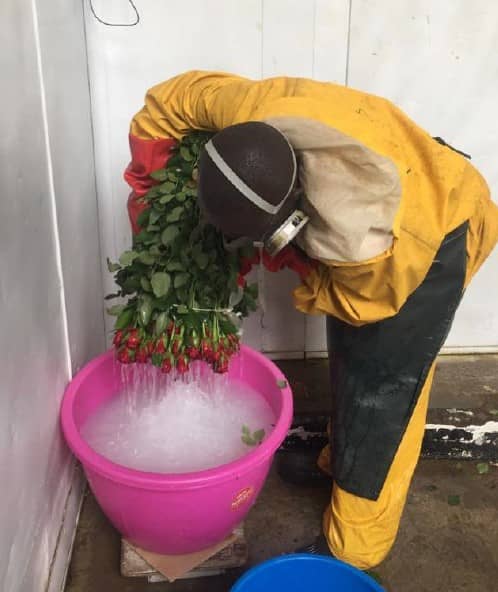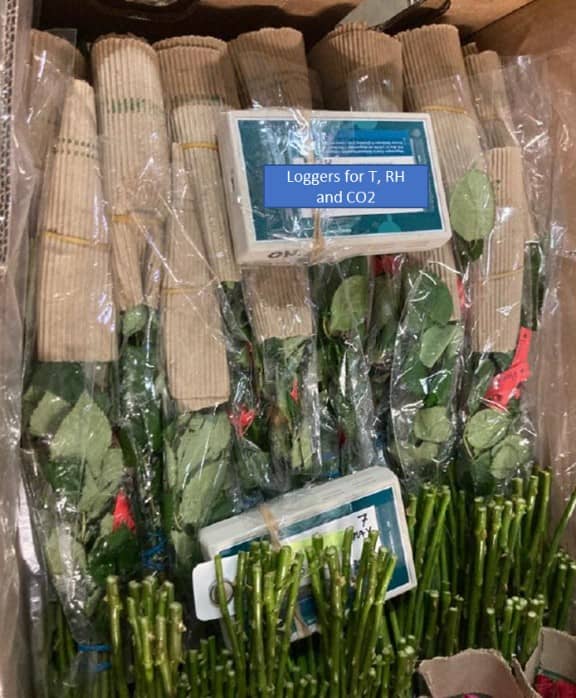Intercontinental ocean shipping of agricultural products is considered more carbon and cost efficient and may provide more flexibility compared to air freight. The Kenyan government is actively supporting sea freight so that Kenya will remain competitive in a global market. Although sea transport is already common practice for some Kenyan fruit (avocado, pineapple), for flower export this option is still poorly explored.
Written by Ernst Woltering from Wageningen Food and Biobased Research and Nieves Garcia from Wageningen Greenhouse Horticulture.
Studying vase life at Wageningen University
A sustainable trade route for Kenya
Due to the global increasing demand for flowers, Kenya’s production and export is steadily increasing.
"There is a long standing wish among Kenyan producers as well as among the Dutch flower importers to make the transition from air to sea shipment."
There are several arguments to choose for sea transportation over air transportation. Sea shipments considerably reduce transportation cost (to about 50% compared to air transportation) and provide much more flexibility and satisfy the need for increased transportation capacity especially during holydays (Valentine’s day, mother’s day). It has been shown in several recent investigations that the transportation of roses in refrigerated (reefer) containers is possible.
However, sea transportation has not yet become common practice in the transport of roses from Kenya to The Netherlands. A major challenge in sea transport are the long transport times (30-35 days) to reach the major destinations in Europe. Without proper treatments, roses may not survive the trip in good quality.
Bottlenecks in the chain
The outcome of rose shipments over sea is, therefore, variable and often disappointing. After arrival in Europe, roses should be able to withstand a 3-4 day period in the retail channel and should have a remaining vase life at the consumer of at least 7 days of acceptable quality. Main problems that are invoked by the long transport time are failure of flower opening, leaf desiccation and fungal infections.
The elucidation of the reasons for the variability in flower quality at arrival is complicated by a multitude of factors. There are many different rose cultivars used in the shipments and they come from a variety of growers. On top of this, different postharvest treatments and protocols are applied. Together this makes it hard to pin point the main bottlenecks in the chain.
In 2021 therefore a pilot experiment was executed with financial support from the Netherlands Ministry of Agriculture, Nature and Food Quality. The experiment involved a number of Dutch flower traders and technical and logistical service providers to get more insight in failure and success factors for sea freight.
Factors that contribute to the sea freight variability
The aim of this project was to better understand the factors that contribute to the variability in outcome of sea shipments of cut roses from Kenya to Rotterdam. “Especially we focused on the contribution of “cultivar” and “grower” to the final outcome (in particular the flower failure and leaf desiccation issues)” explains Ernst Woltering. For this reason, the consortium organized a pilot shipment consisting of different rose cultivars sourced from different growers in the Naivasha region. As much as possible all postharvest factors (pre-treatments, anti-fungal dip, temperature management, vacuum cooling and conditions in the reefer) were held similar for all the flowers. This set-up allowed us to compare the performance of different cultivars and to investigate the contribution of “grower” to the outcome.
One of the main focus points was Leaf Quality and vase life. During the pilot we found a big variability between different cultivars in relation to vase life. Independent of the grower, some always performed better than other cultivars. The same was true for flower opening and the vase life. Also we found a clear effect of the grower. Independent of the cultivar, flowers of some growers performed better than the flowers from other growers.
This shows that both cultivar and grower have a significant impact on the final quality of the roses after the shipment. Currently we do not know the underlying reasons for these differences. All these cultivars generally perform well, irrespective the grower, when they are transported by airplane. The long storage time apparently has more impact on specific cultivars and on flowers from specific growers.

Roses being dipped in an antifungal solution before shipment 
Roses packed in boxes with sensors for monitoring temperature, relative humidity and CO2 concentrations during the trip
Future planning
A new 3 year project was recently started. Employing up to 12 pilot shipments and a range of interventions both at the grower and in the chain, we will further investiagte the cultivar and grower related factores that determine the end result. The final aim is to develop and demonstrate improved protocols, desision models and recommendations for succesful sea shipment of flowers to all players in the chain from grower to retail shop.
For more information on the pilot kindly contact Ernst Woltering via Ernst.Woltering@WUR.NL. For questions for the agricultural counsellor feel free to contact us via nai-lnv@minbuza.nl. For the latest updates follow us on twitter @NLAgriKenya or register for our newsletter by sending an email.